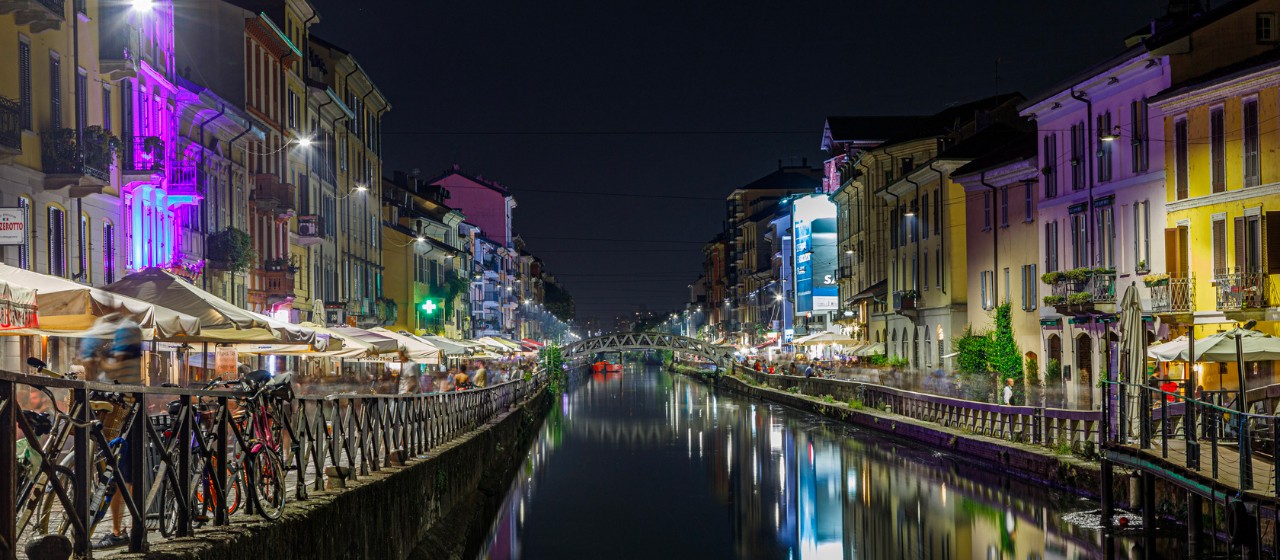The Navigli are a world apart, waiting to be discovered.
They take you farther than you think: in time, with the arts and vintage markets; in leisure moments, with the liveliest nightlife in town; in sports and open-air activities, like canoeing, walking or cycling.
Originally the city’s freshwater harbour, where all kinds of goods were unloaded from barges, including the marble blocks for the construction of the Duomo, which stopped here on their way to the building site). Most of what the city needed came right through these streets and Leonardo da Vinci, Milano’s adopted resident genius, extensively studied the canals and drew up important projects for the city’s water system.
Since its renovation in 2015, the Darsena has been considered Milano’s little Riviera: a must for tourists, a place of markets and flavours, as well as a meeting point for those willing to spend some time relaxing along the Navigli.
One of the most successful locations of the city on Instagram, a small backstreet with a tiled roof and old stone slabs, relics of a past when laundry was hand-washed. Washerwomen had their own assigned places and did the laundry for the entire neighbourhood. A true must during a Navigli visit.
Un monumento verde. Se passi da piazza XXIV Maggio, noterai un grande albero solitario. Si tratta di una quercia del 1924, piantata alla fine della Prima Guerra Mondiale dalla famiglia Capè, in memoria del giovane figlio e dei compagni caduti sul campo. È l’albero più vecchio della città a essere stato piantato “per non dimenticare” e oggi è un silenzioso testimone dei cambiamenti della città.
On the last Sunday of every month, the Mercatone dell’Antiquariato (Antiques Market) is a must for all vintage lovers. There, you will not only find clothes, but also furniture and objects of all kinds: books, comics, decorative and collectable items.
Twice a year, in spring and in autumn, the Naviglio comes alive thanks to the Mercato dei Fiori e dei Sapori (Flower and Flavours Market): a perfumed and colourful event, involving nursery gardeners from all over Italy but focusing on the flavours of the Italian culinary tradition as well.
Milano was once the capital of the western half of the Roman Empire and these very well preserved columns in Corinthian style are a reminder of that glorious time. They are located right in front of the Basilica of the same name, exactly half-way between the Duomo and the Navigli, and provide a good starting point for a shopping afternoon or an evening with friends, as well as being a well-known meeting point for hundreds of students during the hottest months of the year.
If you are wondering where to sip your aperitivo, there is only one answer: the Alzaia and the streets around it (Via Vigevano, Via Corsico…) offer plenty of places where you can drink something in the Milanese sunset.
You can also dine and spend the evening there, and take a stroll along the water stream, which in the evening shines with a thousand romantic lights. You will be taking plenty of souvenir photos.
Along the canals, it is possible to train, walk or cycle – all the way to the city of Pavia. Many runners use the banks of the Navigli to do their training or simply to enjoy a stroll in the open air.
By bike, it is possible to reach Abbiategrasso (along the Naviglio Grande) or to get as far as Pavia (along the Naviglio Pavese), through a route that shows ever-changing scenery, from urban landscapes to green areas.
The most important historic canoeing associations have their headquarters on the canals: Canottieri Milano, Olona and San Cristoforo. These clubs have been promoting and teaching canoe culture since their foundation, expanding to other sports and interests as well. However, there is more to it than just canoes and kayaks: what about a romantic excursion on a gondola?
La lunga estate di Milano è Viva rende questi luoghi ancor più attrattivi con i concerti di MiTo e JazzMI, che si svolgono nel periodo dal 16 settembre al 28 ottobre in varie location.
Did you know Porta Genova is the oldest train station in Milano? The historic train and underground stations are our ideal starting point. On the one side, they allow us to easily reach the Navigli area, on the other they take us in no time to “the other fashion district”, also known as Zona Tortona, located right behind the station.

 Log in
Log in


